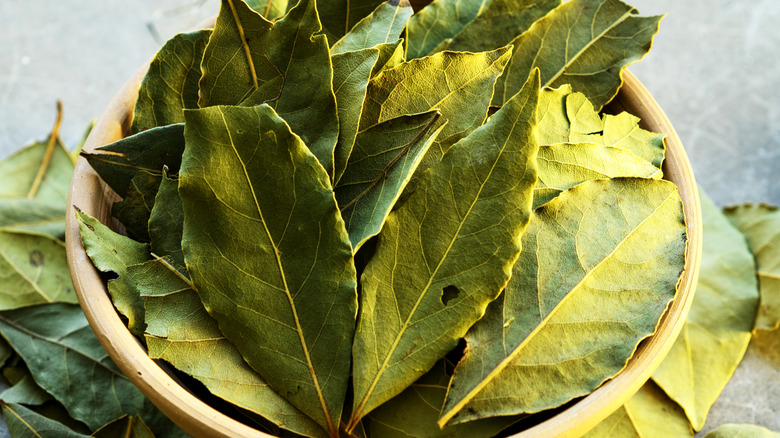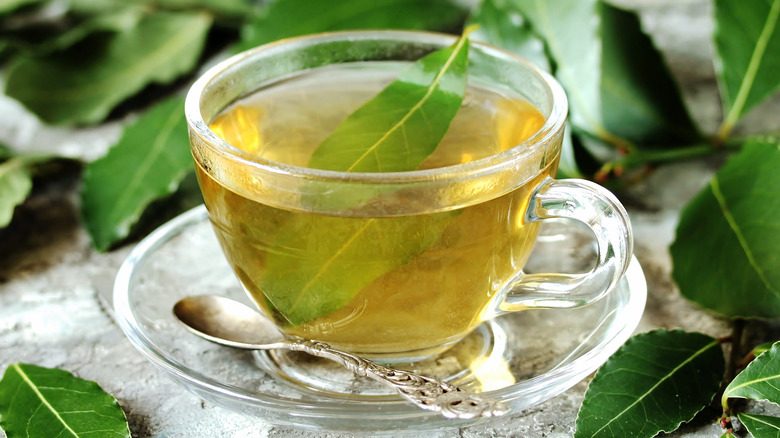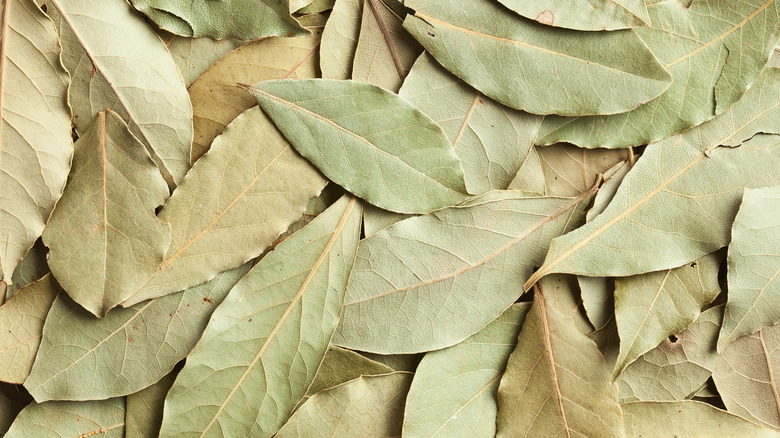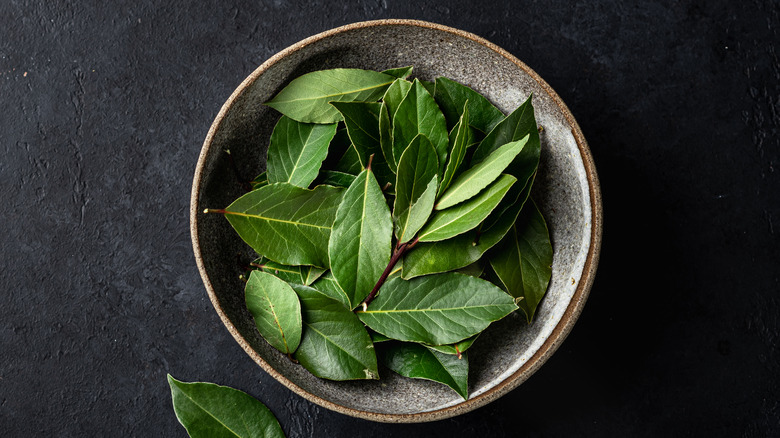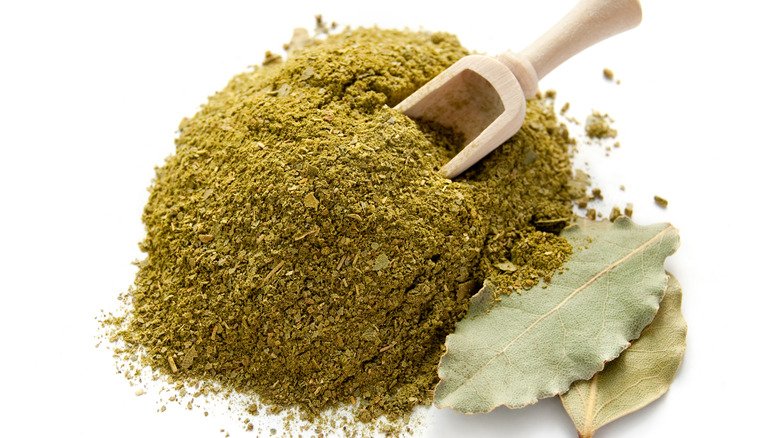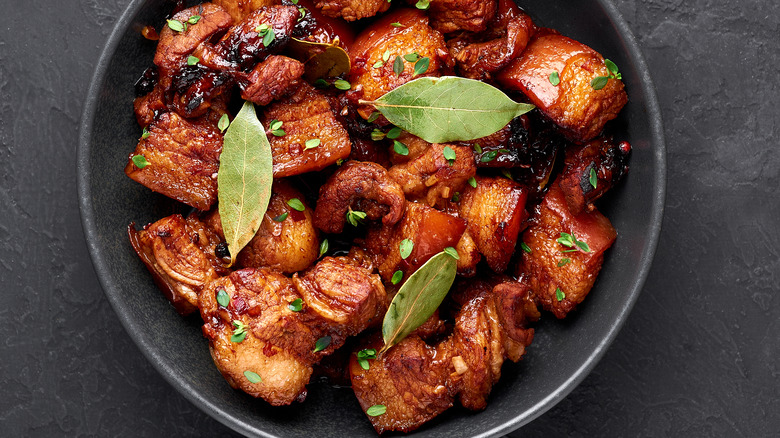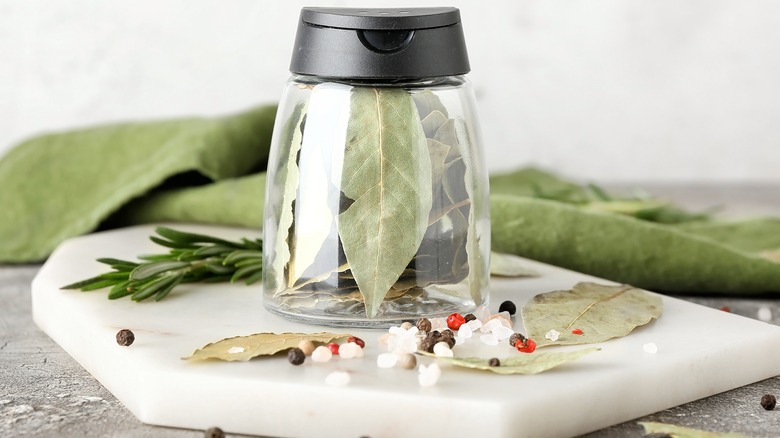What Are Bay Leaves And What Do They Taste Like?
When you think of some of the popular herbs to grace our everyday foods, those like paprika, oregano, basil, and pepper might come to mind. As the seasons change, herbs like mint, cinnamon, ginger, and nutmeg may be used more. But there are some herbs that simply don't get enough recognition, or worse, are deemed useless by those who may not know the proper way to utilize them. Bay leaves are a prime example of this, as some people swear the herb is a tasteless waste, per The Awl, while there are others who use it religiously in specific recipes.
While the public's thoughts on this herb may vary, The Spruce Eats explains that when used correctly, bay leaves can help amplify the flavors from other ingredients, giving your final dish a vibrant and complex taste. Here's what to know about the versatile herb and how to use it in your dishes.
What are bay leaves?
In ancient times, the Greeks and Romans made crowns out of bay leaves for victorious warriors after a battle (per MasterClass). But today, the bay leaf, aka the Laurus nobilis, has more use in the kitchen than as a fashion accessory. Bay leaves originally came from the laurel tree native to the Mediterranean region, but varieties of bay leaves are now grown in various parts of the world with each kind having a different flavor.
There are six varieties of bay leaves, with two being used more commonly than the others. Mediterranean bay leaves, also known as Turkish bay leaves, have a more mild flavor, per Cook's Illustrated. Californian bay leaves, meanwhile, are a bit stronger than the Turkish leaves and are used in stews, sauces, curries, and even ice cream (per Specialty Produce). There are also Indian, West Indian, Indonesian, and Mexican bay leaves.
Bay leaves can be found dried in the herb section of a grocery store or fresh in the produce aisle. The leaves have an aroma similar to that of oregano and thyme, as they are both floral and herbal. They tend to be used in liquid-based recipes that require slow-cooking such as stews and soups, and are removed from the dish before it's served.
What do bay leaves taste like?
What a bay leaf tastes like will depend on the variety of bay leaf that you're using. The most commonly available and used variety is the Mediterranean bay leaf, which is bright green and oval-shaped, per Cook's Illustrated.
The Californian bay leaf has a more potent flavor of eucalyptus, while the Mexican bay leaf has a more subtle flavor. The Indian bay leaf has hints of cinnamon, which makes it unsuitable to be swapped with the Mediterranean or Californian bay leaf, per MasterClass.
While bay leaves have a bad reputation for being as tasteless as the tree leaves they resemble, the mistake many people make with bay leaves is expecting the herb to add a punchy flavor like that of paprika or pepper. On the contrary, this herb offers a truly subtle flavor and The Spruce Eats shares that it's more of a "supporting actor" that helps the other herbs shine.
How to cook with bay leaves
If you're not convinced that a bay leaf has flavor, Serious Eats suggests boiling a handful in plain water. After a few minutes, the smell from the bay leaves simmering will be similar to that of Vick's VapoRub — eucalyptus and menthol. After some further simmering, the strong menthol and eucalyptus scent will be replaced by the aroma of herbal tea, which is the actual flavor that the bay leaf will add to your dish.
The trick to making the best use of bay leaves in food is to infuse them in hot, liquid-based dishes and letting them simmer along with the other ingredients.
Food & Wine reports that this herb is beloved by the French, used in hot liquid-based dishes like sauces, soups, and broths. Texans appreciate the bay leaf as well, particularly in gumbo and chili. Masterclass reports that the Indonesian bay leaf is often used directly on meat, as part of a marinade or a rub and the Indian variety is used in spice mixtures as well as in curries.
Fresh vs. dried bay leaves
As with most herbs, bay leaves can be found in two forms: fresh and dried. Different cooks and chefs have varying preferences over which form of bay leaf is better, but they'll both impart flavor into your dishes.
Per The Spruce Eats, dried bay leaves can offer a far better flavor than fresh ones, specifically if they are used soon after they have been dried. As a fresh bay leaf is dried, not only does its color become duller, but its flavor also becomes intensified. Fresh bay leaves tend to be on the bitter side, which turns more herbal in flavor once it's dried. Per MasterClass, two fresh bay leaves are the equivalent of one dried bay leaf when measuring for recipes.
Dried bay leaves in the United States almost always come from Turkey — the Mediterranean variety — and these tend to be more subtle in flavor than the fresh bay leaves from California that supermarkets sell. These fresh Californian leaves have a stronger flavor of eucalyptus which might not be the flavor you're aiming for looking for in a hearty beef stew.
Are bay leaves nutritious?
WebMD reports that one tablespoon of crushed bay leaves contains only 5.6 calories, and less than one gram of protein, sugar, fat, carbohydrates, and fiber. Although the herb contains a minimal amount of vitamins and minerals, according to Healthline, bay leaves have been used throughout history for health purposes. The herb is a good source of antioxidants because it contains polyphenols, which can help control and prevent diabetes and certain cardiovascular diseases. The site reports that some studies have also indicated consuming one to three grams of the herb daily may help regulate glucose and cholesterol levels in the body.
If you are new to using bay leaves in your dishes, Verywell Fit cautions that they do not break down as other herbs do while cooking. The leaves can also be a choking hazard, so it's wise to pick them out prior to serving the dish. The herb isn't digestible, either, and The Spruce Eats warns that the sharpness of a bay leaf can easily cut the inside your mouth, as well as the insides of the digestive tract.
What is the best way to store bay leaves?
Dried bay leaves have a shelf life that far exceeds that of fresh bay leaves. They can be stored in an airtight bag in the freezer to help retain the flavor for a longer period of time, but considering how subtle the flavor of the bay leaf already is, it might be best to buy a new jar of bay leaves every few months, per The Spruce Eats.
Fresh bay leaves tend to be a bit more expensive than the dried version. If you're splurging on the fresh herb, it would be wise to store it properly so that it lasts longer. When sealed in an airtight bag and put in the refrigerator, bay leaves should stay fresh for up to two weeks. When stored in the freezer, they should last even longer, helping to preserve flavor and potency, per The Spruce Eats.
